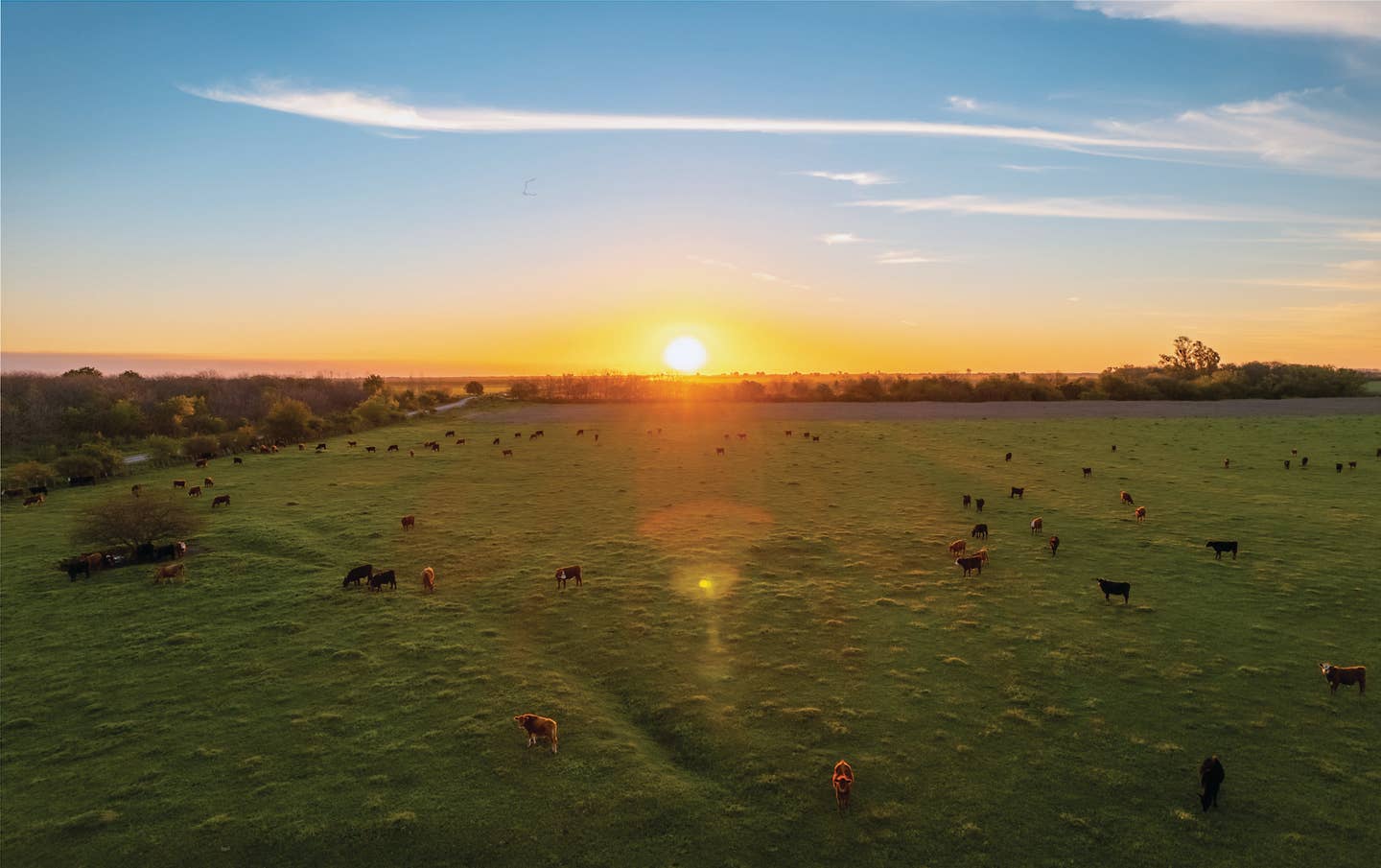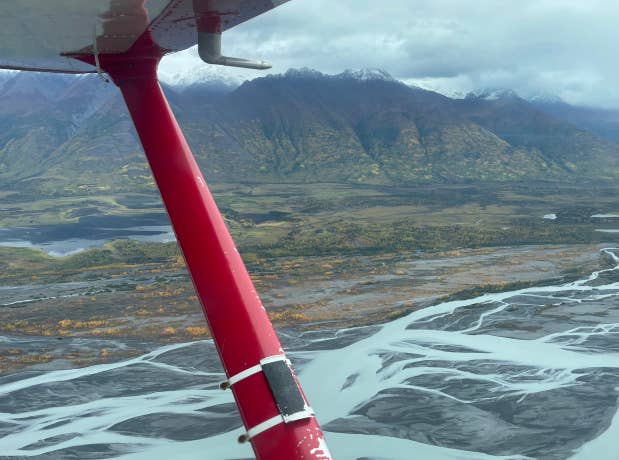
Aerial view of cows loose in the field during the summer at sunset echoes the central Florida countryside. [Adobe Stock]
"Do you want to fly to Lakeland and back?” It’s my friend Tom with an offer to fly from Tampa Executive Airport (KVDF) to KLAL, a distance of 17 nautical miles, for an airplane swap. By airplane swap, I mean just that. Tom owns not one, but two Aerostars. We’ll take Mike Echo to Aeromech for an annual and fly back in Juliet Alpha. How could such an enticing invitation turn my mood so sour?
Actually, I started out already feeling somewhat bummed. I’ve been licking my wounds ever since selling our Cessna Citation CJ1 jet. Insurance costs have increased dramatically, especially for older single-pilot ops in jets. Looking for a new (to me) airplane has been depressing. I’ve had it with the ominous, threatening letters from the Manager, Aerospace Medical Certification Division in Oklahoma City, Oklahoma (“You must promptly report any adverse changes...You are cautioned to abide by Title 14 of the Code of Federal Regulations...”), and have decided to transition to Basic Med. This limits the maximum takeoff weight (MTOW) to 6,000 pounds. I don’t remember meeting this doctor when I took the AME course several years ago, but I do remember the vibe of the class.
If you're not already a subscriber, what are you waiting for? Subscribe today to get the issue as soon as it is released in either Print or Digital formats.
Subscribe NowMy thoughts turned to finding a Cessna 340 with fond memories of “6828 Charlie,” a beautiful 340 that my wife, Cathy, and I enjoyed from 1995 to 2000. The original certified MTOW was 5,990 pounds, which should qualify. The only trouble is almost all 340s have been improved with RAM programs that increase the MTOW to about 6,300 pounds. Is it the improved MTOW that counts or the originally certified weight? I am not going to be the guy to test that theory. Some A&Ps have suggested that the vortex generators installed to improve stall speed and increase MTOW could be removed and make a 340 eligible for Basic Med. What a thought.
Some friends have recommended the Beechcraft Baron. Though the airplane would have to be flown below 18,000 feet to qualify for Basic Med, a “kit” from Textron makes the slightly overweight airplane eligible for the program. Why Textron hasn’t provided a similar kit for the 340 is a puzzle. It is also clear that there are Baron lovers and there are 340 lovers.
The fact is, the insurance industry and the FAA have stimulated me to abandon a really safe turbine engine jet for a piston twin with the attendant excitement that comes with engines that have parts changing directions more than 30 times per second. Add to that the removal of the vortex generators designed to enhance safety. Now I’ll be plowing around in lower altitudes in weather with less reliable engines. How this improves the fortunes of my insurance company is not clear to me.
Armed with these ruminations, I joined Tom for the short flight. More grim news was immediately evident. Tom’s hangar lease at KVDF is not being renewed. Hangar space is scarce around these parts (the Tampa-St. Petersburg metro area), and losing a slot is a blow. Apparently, he parked a car in the hangar against the rules. I know from personal experience that the FBO at KVDF is big on rules.
Tom’s longtime repair shop, Aeromech at KLAL, is closing after 30 years. Kenny, the owner, told us, “I can’t get parts. I can’t get grease for bearings. Cylinder repair shops can’t get valves, can’t get vanes. There’s a shop in Indiana with hundreds of cylinders sitting on the bench (starving for) parts. Add to that my hangar rent is tripling. I’m going to go home and raise strawberries.”
He agreed to fit Tom in for an annual before closing day. His staff members were unsure as to what they planned to do next.
Many Cessna 340s and Barons are more than 40 years old. What about parts in the future, and what about the fate of avgas? I haven’t even begun to examine all the forces that seem to be wishing me to drive, not fly, into the sunset—in a recreational vehicle, not an airplane.
But the primitive desire to own an airplane is rearing its not-to-be-denied-or-disrespected head. At the moment, I am a hangarless, airplaneless 77-year-old who has enjoyed airplane ownership virtually without interruption for more than 50 years. There have been times when I could barely afford an airplane. There have been times when I just couldn’t fly very often. There have been times when I thought it was time to quit. Somehow, though, I just can’t see it ending now. I think back to that first airplane, a Musketeer, and its subsequent siblings: the Arrow, the Cessna 210, the P210, the 340, the Piper Cheyenne, the Raytheon Premier, and the CJ1. Each of these airplanes gave me purpose and pride. They coaxed me into relationships with amazing mechanics possessed of accumulated wisdom and, oftentimes, a gentle perspective on life. These airplanes and their A&Ps, the line guys and the ATC controllers, held my hand in times of woe.
There certainly is rich irony here. Just as my day job as a surgeon and my retirement job as a Part 135 Citation CJ3 pilot provided me with the money to own, and experience to fly, a CJ1, I’m being elbowed out of my dream airplane. I get the same sense of wistfulness at a high-end steakhouse. I can finally afford that 12-ounce filet mignon, but I can’t possibly eat it. Ain’t that something?
Tom offered to let me fly his other Aerostar back to KVDF, but I just didn’t have the heart to accept this kindness. Flying is joyful, and I wasn’t feeling that way. So I looked out the window at the cows and homes and listened to the AWOS. I watched as a high-time airline pilot and Aerostar guru chirped his airplane safely home. We tugged the airplane into the hangar, and I watched with alarm as the hangar door cleared the nose by an inch. We agreed that we’d both live to fight another day.

Sign-up for newsletters & special offers!
Get the latest FLYING stories & special offers delivered directly to your inbox







